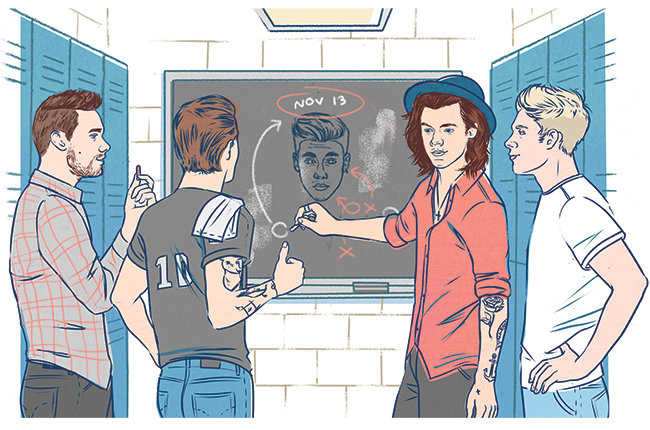When One Direction and Justin Bieber release new albums on Nov. 13, it won’t be the first time two giants of one genre faced off in a race to the top of the charts.
Back in 2007, Kanye West and 50 Cent chose the same Tuesday to drop highly anticipated studio efforts — Graduation and Curtis, respectively — essentially engaging in a high-stakes game of retail chicken. 50 even bragged that he would retire if West’s album outsold his (a claim he later modified). By the time the dust settled, West had crushed 50, 957,000 units to 691,000 (according to Nielsen Music), and the Queens rapper’s music career never quite recovered.
Artists commonly steer clear of releasing music on the same day — The Beatlesand The Rolling Stones famously cooperated to avoid tripping over each other’s release dates — so Sony Music’s decision to launch its boy band’s fifth Columbia Records album, Made in the A.M., on the same Friday that Universal Music Group’s Def Jam Records is pumping Bieber’s first new album in three years feels counter-intuitive. After all, pitting acts with similar teen appeal against each other results in “competing for the same dollar,” grouses one merchant. “Talk about a screwed-up industry.” (Worth noting: Multiple sources contend the 1D album was moved from Nov. 20 to make way for the new album from fellow Columbia act Adele.)
But with the drop in album sales in the past decade, such a concern seems like a relic of a bygone era. And, in fact, it is: Thanks to subscription services like Spotify and Apple Music — the sector overall had a 97 percent increase in streams between September 2013 and September 2014 — it’s no longer one or the other.
“Who will win the streaming counts will come down to how Bieber and One Direction are promoted at whichever service the fans are using,” says one industry data analyst, adding that today’s “consumption smackdown isn’t as exciting as the sales showdown.”
Indeed, Bieber’s position at Spotify has played a key role in the rollout for “What Do You Mean?,” the first single from his still-untitled fourth album. A week after the song went to radio, the label boasted about its “aggressive Spotify strategy that resulted in over 40 million plays worldwide, a new record.” It also landed Bieber his first Billboard Hot 100 No. 1. One Direction’s “Drag Me Down,” on the other hand, looks to have peaked at No. 3.
In downloads, however, both acts are on an even plane (Bieber notched 337,000 sales of “What Do You Mean?” in its first week; One Direction moved 350,000). The same could be said of reaching make-or-break points in their respective careers. Bieber is still recovering from a series of fan base-alienating misdeeds (although a recent charm offensive — which includes a tearful appearance at the MTV Video Music Awards in August — seems to be paying off dividends), while One Direction is nearing the end of a four-year whirlwind that cost the group a founding member, Zayn Malik. The band has confirmed that it will be taking a hiatus in 2016.
Of course, all of this teen-focused speculation is bound to increase the attention on both acts, not unlike the Blur vs. Oasis days, and industry insiders are licking their chops at the prospect of big upticks in traffic to “stores” — whether they be physical, digital or streaming sites. Laura Provenzano, senior vp purchasing and marketing at Alliance Entertainment, concurs. “Maybe at a different time of the year sales cannibalization is a worry,” she says, “but the holiday tips the scale toward incremental sales.”
No matter who scales the summit first, the winner looks to be the music business. And this may only be the beginning of a banner quarter, as one retail insider notes that several major album releases are still unannounced — among them West, Beyoncé, Rihanna and a certain Grammy favorite from the United Kingdom.


